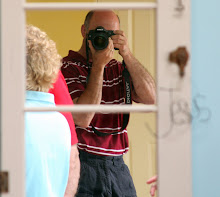Another factor is the magnification of the water, where things appear 25% larger or closer than they really are.This causes one to think they are more intimate with their subject than they really are.
Putting everything together, getting closer reduces the particles between you and the subject and using a strobe up and away allows the light to be directed at an angle where the reflected light will be away from the lense, eliminating or reducing the backscatter.
Now, why am I telling all of this? Well, because at the time we were in the islands, we met Irene as a tropical storm, before becoming a hurricane. She dumped quite a lot of rain on the islands as she passed to the south of us and provided a great deal of run-off into the Caribbean reducing the visability for our diving for the week and added alot of extra particles to have to avoid. The images below were shot up close and personal on a night dive later in that week.







2 comments:
Bob, These pictures are fantastic! I love them all but especially the butterflies - Amazingly beautiful.
King Counts
Thanks!
Post a Comment